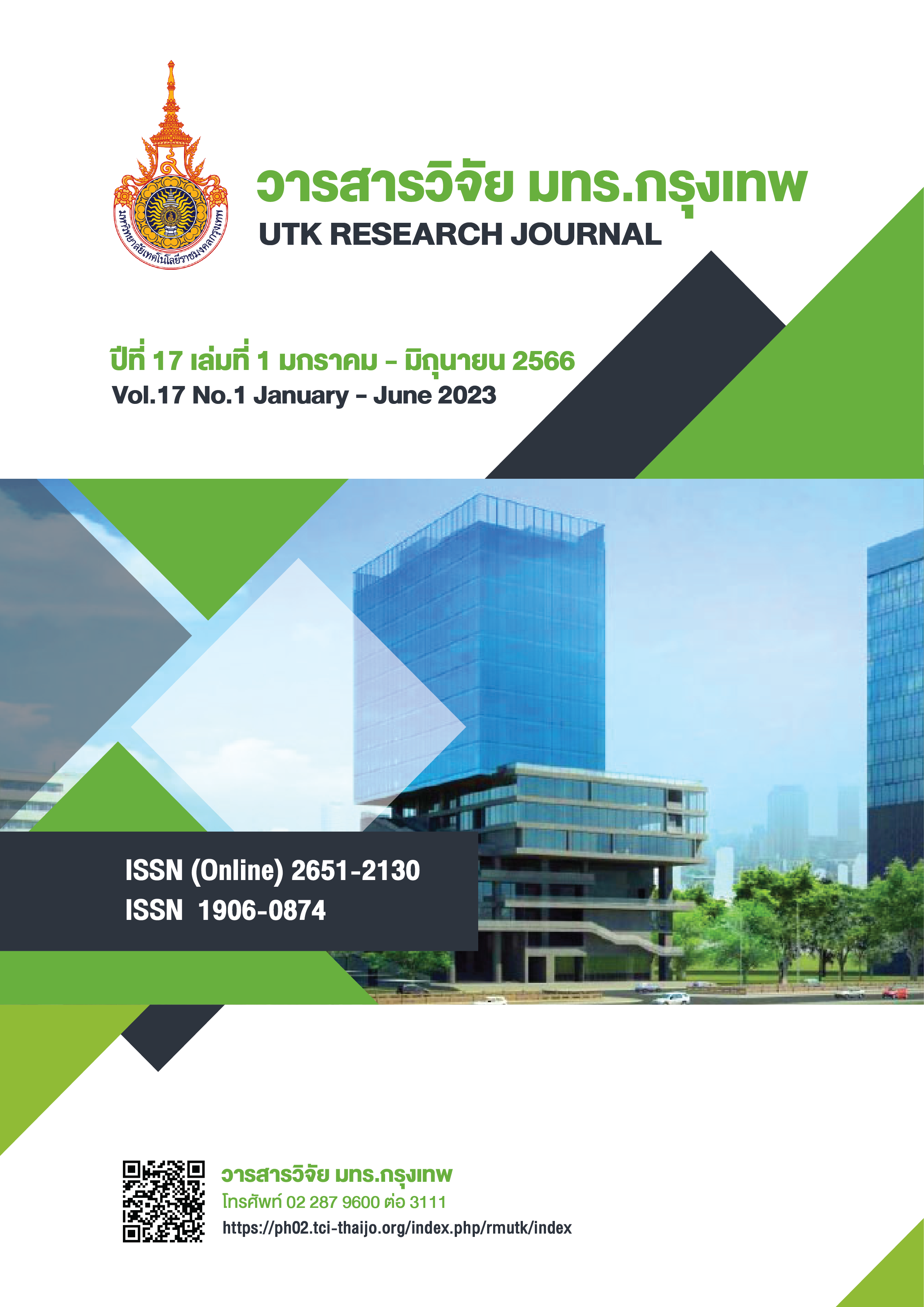ประสิทธิภาพการลดการปนเปื้อนของไกลโฟเสตในดินด้วยจุลินทรีย์คัดสายพันธุ์
คำสำคัญ:
จุลินทรีย์คัดสายพันธุ์, ไกลโฟเสต, ประสิทธิภาพการกำจัดบทคัดย่อ
งานวิจัยนี้เป็นการศึกษาประสิทธิภาพการลดการปนเปื้อนของไกลโฟเสตในดินด้วยจุลินทรีย์คัดสายพันธุ์ ประกอบด้วย Pediococcus sp. Bacillus subtilis และ Bacillus licheniformis โดยในการดำเนินงานวิจัยจะทำการวิเคราะห์สมบัติทางกายภาพและสมบัติทางเคมีของดินที่นำมาใช้ในงานวิจัย จากนั้นวิเคราะห์ประสิทธิภาพการลดการปนเปื้อนของไกลโฟเสตในดิน ออกแบบการทดลองโดยแปรผันความเข้มข้นของไกลโฟเสตเพื่อติดตามความเปลี่ยนแปลง เป็นระยะเวลา 7 วัน จากนั้น เก็บตัวอย่างดินเพื่อไปวิเคราะห์ปริมาณของไกลโฟเสตด้วยเทคนิคแก๊สโครมาโตกราฟี (Gas Chromatography: GC) และนำมาคำนวณประสิทธิภาพการลดการปนเปื้อนของไกลโฟเสต จากผลการวิจัยพบว่า คุณสมบัติดินที่ใช้ในการวิจัยมีลักษณะเป็นดินเหนียว และค่าอินทรีย์วัตถุในดินตัวอย่างมีปริมาณ 26 กรัมต่อกิโลกรัม ซึ่งอยู่ในระดับปานกลาง โดยมีค่าพีเอช 6.58 ซึ่งเป็นกรดอ่อน ในส่วนการลดการปนเปื้อนของไกลโฟเสตนั้นพบว่า เมื่อใช้ปริมาณของจุลินทรีย์คัดสายพันธุ์ 10 กรัม และความเข้มข้นของไกลโฟเสต 240 มิลลิกรัมต่อกิโลกรัมนั้น จะให้ประสิทธิภาพการกำจัดไกลโฟเสตมากกว่าการใช้ความเข้มข้นของไกลโฟเสต 120 มิลลิกรัมต่อกิโลกรัม คือ ร้อยละ 91.69 และ ร้อยละ 90.81 ตามลำดับ ดังนั้น จากงานวิจัยนี้สามารถนำไปประยุกต์ใช้ในการจัดการไกลโฟเสตที่ตกค้างในดินที่เกิดขึ้นในภาคเกษตรโดยใช้จุลินทรีย์คัดสายพันธุ์ จากงานวิจัยนี้ได้อีกด้วย
เอกสารอ้างอิง
Gill JPK, Sethi N, Mohan A. Analysis of the glyphosate herbicide in water, soil and food using derivatising agents. Environ Chem Lett. 2017;15(1):85-100.
Zhang C, Hu X, Luo J, et al. Degeneration Dynamics of Glyphosate in Different Types of Citrus Orchard Soils in China. Molecules. 2015;20(1): 1161-75.
Singh S, Kumar VA, Gill JPK, et al. Herbicide Glyphosate: Toxicity and Microbial Degeneration. Int J Environ Res Public Health. 2020;17(20):7519.
Banks ML, Kennedy AC, Kremer RJ, et al. Soil microbial community response to surfactants and herbicides in two soils. Soil Ecol. 2014;(74):12-20.
Cassigneul A, Benoit P, Bergheaud V, et al. Fate of glyphosate and degradates in cover crop residues and underlying soil: A laboratory study. Sci Total Environ. 2016;(545-546):582-90.
Okada E, Costa JL, Bedmar F. Adsorption and mobility of glyphosate in different soils under no-till and conventional tillage. Geoderma. 2016;(263):78-85.
Sidoli P, Baran N, Angulo-Jaramillo R. Glyphosate and AMPA adsorption in soil: laboratory experiments and pedotransfer rules. Environ Sci Pollut Res. 2016;23(6):5733-42.
Simonsen L, Fomsgaard IS, Svensmark, B, et al. Fate and availability of glyphosate and AMPA in agricultural soil. J Environ Sci Health B. 2008;43(5):365-75.
Sviridov AV, Shushkova TV, Ermakova IT, et al. Microbial degradation of glyphosate herbicides (Review). Appl Biochem Microbiol. 2015;51(2):183-90.
Travaglia C, Masciarelli O, Fortuna J, et al. Towards sustainable maize production: Glyphosate detoxification by Azospirillum sp. and Pseudomonas sp. Crop Protection. 2015;77(6):102-9.
Bergstrom L, Borjesson E, Stenstrom J, et al. Laboratory and lysimeter studies of glyphosate and aminomethylphosphonic acid in a sand and a clay soil. J Environ Qual. 2011;40(1):98-108.
Porto AM, Melga GZ, Kasemodel MC, et al. Biodegradation of Pesticides. Pesticides in the Modern World – Pesticides Use and Management. 1st ed. Rijeka: In Tech; 2011.
Singh BK, Walker A, Morgan JA, et al. Microbial degradation of organophos-phorus compounds. FEMS Microbiol Rev. 2006;30(3):428-71.
Singh BK, Walker A, Morgan JA, et al. Effects of soil pH on the biodegradation of chlorpyrifos and isolation of a chlorpyrifos-degrading bacterium. Appl Environ Microbiol. 2003;(69):5198-5206.
Singh BK, Walker A, Morgan JA, et al. Biodegradation of chlorpyrifos by Enterobacter strain B-14 and its use in bioremediation of contaminated soil. Appl Environ Microbiol. 2004;70(8):4855-63.
Huang Y, Xiao L, Li F, et al. Microbial Degradation of Pesticide Residues and an Emphasis on the Degradation of Cypermethrin and 3-phenoxy Benzoic Acid: A Review. Molecules. 2018;23(9):2313.
USDA Natural Resources Conservation Service. Soil Survey Laboratory Methods Manual. No. 42. Version 4.0. Washington DC: Soil Survey Investigation Report; 2004.
Borjesson E, Torstensson L. New methods for determination of glyphosate and (aminomethyl)phos-phonic acid in water and soil. J Chromatogr A. 2000;886(1-2):207-16.
Teerakun M, Saraphirom P, Reungsang A. Optimization of Paraquat Degradation by Microbial Consortium from Rhizosphere Soil. EAU Herit J. 2017;11(2):90-99.
Yu XM, Yu T, Yin GH, et al. Glyphosate biodegradation and potential soil bioremediation by Bacillus subtilis strain Bs-15. Genet Mol Res. 2015;14(4):14717-30.
Castrejon-Godinez ML, Tovar-Sanchez E, Valencia-Cuevas L, et al. Glyphosate Pollution Treatment and Microbial Degradation Alternatives, a review. Microorganisms. 2021;9(11):2322.
Singh S, Kumar VA, Singh J, Kinetic study of the biodegradation of glyphosate by indigenous soil bacterial isolates in presence of humic acid, Fe (III) and Cu (II) ions. J Environ Chem Eng. 2019;7(3):103098.
Van Bruggen AHC, He MM, Shin K, et al. Environment and health effects of the herbicide glyphosate. Sci Total Environ. 2018;616-617(3):255-68.
ดาวน์โหลด
เผยแพร่แล้ว
รูปแบบการอ้างอิง
ฉบับ
ประเภทบทความ
สัญญาอนุญาต
ลิขสิทธิ์ (c) 2023 วารสารวิจัย มทร. กรุงเทพ

อนุญาตภายใต้เงื่อนไข Creative Commons Attribution-NonCommercial-NoDerivatives 4.0 International License.
กองบรรณาธิการวารสารวิชาการ มหาวิทยาลัยเทคโนโลยีราชมงคลกรุงเทพ มีความยินดีที่จะรับบทความจากอาจารย์ นักวิจัย นักวิชาการทั้งภายในและภายนอกมหาวิทยาลัย ในสาขาวิชาวิทยาศาสตร์และเทคโนโลยี ได้แก่ สาขาวิชาวิทยาศาสตร์ วิศวกรรมศาสตร์ และสาขาอื่นๆ ที่เกี่ยวข้อง รวมถึงสาขาต่างๆ ที่มีการบูรณาการข้ามศาสตร์ที่เกี่ยวข้องวิทยาศาสตร์และเทคโนโลยี ที่เขียนเป็นภาษาไทยหรือภาษาอังกฤษ ซึ่งผลงานวิชาการที่ส่งมาขอตีพิมพ์ต้องไม่เคยเผยแพร่ในสิ่งพิมพ์อื่นใดมาก่อน และต้องไม่อยู่ในระหว่างการพิจารณาของวารสารอื่น
การละเมิดลิขสิทธิ์ถือเป็นความรับผิดชอบของผู้ส่งบทความโดยตรง บทความที่ได้รับการตีพิมพ์ต้องผ่านการพิจารณากลั่นกรองคุณภาพจากผู้ทรงคุณวุฒิและได้รับความเห็นชอบจากกองบรรณาธิการ
ข้อความที่ปรากฏอยู่ในแต่ละบทความที่ตีพิมพ์ในวารสารวิชาการเล่มนี้ เป็นความคิดเห็นส่วนตัวของผู้เขียนแต่ละท่าน ไม่เกี่ยวข้องกับมหาวิทยาลัยเทคโนโลยีราชมงคลกรุงเทพแต่อย่างใด ความรับผิดชอบด้านเนื้อหาและการตรวจร่างบทความแต่ละบทความเป็นของผู้เขียนแต่ละท่าน หากมีความผิดพลาดใดๆ ผู้เขียนแต่ละท่านจะต้องรับผิดชอบบทความของตนเองแต่ผู้เดียว
กองบรรณาธิการขอสงวนสิทธิ์มิให้นำเนื้อหา หรือข้อคิดเห็นใดๆ ของบทความในวารสารวิชาการ มหาวิทยาลัยเทคโนโลยีราชมงคลกรุงเทพ ไปเผยแพร่ก่อนได้รับอนุญาตจากกองบรรณาธิการ อย่างเป็นลายลักษณ์อักษร ผลงานที่ได้รับการตีพิมพ์ถือเป็นลิขสิทธิ์ของวารสาร






